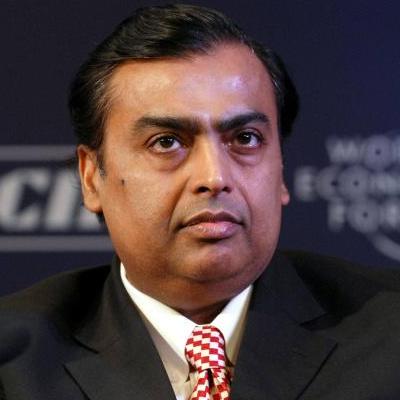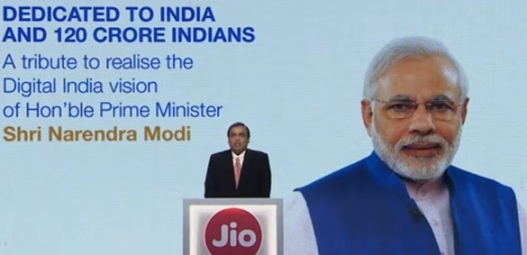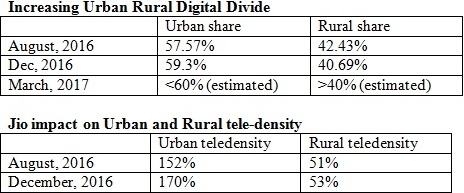  Reliance Industries Ltd (RIL) has created a big hype around Digital India. It has been promoting its telecom subsidiary Reliance Jio as a key driver of Digital India. The ground reality, however, is very different and telecom regulatory authority of India (TRAI) has played an important role in it.
Jio’s entry has increased urban rural digital divide and has depleted Universal Service Obligation fund (USOF)—a fund government has created to build rural telecom infrastructure -- by about Rs 1,600 crore in the fiscal ending March 31, 2017.
The depletion is largely because telecom industry revenues have seen a big fall after the entry of Jio as contribution to the USOF is based on a share of total revenues. The fall in revenues seriously hampers government’s ambitious project of providing connectivity in rural and remote areas, which is backbone of Digital India. The Secretary DOT, J.S.Deepak, who was recently moved out of the Telecom Dept, has officially warned about the depleting revenues of the industry by writing a letter to TRAI chairman R S Sharma.
When RIL chairman Mukesh Ambani launched 4G services in its AGM in September, last year, he said: “I want to dedicate the commencement of Jio to the Digital India vision of our prime minister….” The power point presentation on the backdrop screen had a big photograph of the PM Narendra Modi with a caption: “A tribute to realise the Digital India vision of the Prime Minister Narendra Modi.”
Next day cover pages of leading newspapers carried full page photograph of the Prime Minister in Jio’s advertisements.

What is Digital India
We need to clarify what is Digital India. Is it providing high speed Internet in urban areas at low price or free, as is being propagated by Reliance Jio?
The ministry of IT defines vision of Digital India as: “Digital infrastructure as a utility to every citizen, governance and services on demand, and empowerment of citizen.” The Digital India document of IT ministry talks about providing e-education, health and governance services as its aim. Its main objectives include providing “public internet in 2.5 lakh villages by March, 2017’ and “broadband to all by March 2017.”
In a nutshell, Digital India is to empower common people using broadband by providing e-governance, education and health services to them even in remote areas. It aims to bridge the gap between haves and have-nots, between rural and urban areas.
Interestingly, Digital India document under NDA government was prepared by the existing chairman of telecom regulatory authority of India (TRAI) R S Sharma, when he was secretary of the ministry of IT in his previous job. Sharma is now accused of showering favours to Reliance Jio at the cost of the whole industry and Digital India. For details please read: (https://thewire.in/120866/reliance-jio-trai-biased/)
Status of Digital India
As on March 31, 2017, only 17,000 Village Panchayats could be provided broadband connectivity as against a target of 2.5 lakh Village Panchayats. It clearly shows that the rural areas are still deprived of broadband. The government schemes of providing connectivity in remote and rural areas are not very successful and private operators are not interested in going to remote places.
Services such as e-education, tele-medicine and e-governance, which are supposed to empower common people, are non-starter for all practical purposes.
Reliance Jio Effect: Increasing Urban and Rural digital divide
Reliance Jo launched its services in September, 2016. If we look at the TRAI data, it becomes clear that the urban and rural divide has increased since Jio launched its services.
Urban tele-denity increased to 170% from 152% with first three months of launch of Jio, while rural increased by only 2% to 53%. Share of rural subscribers declined by 2% to 40.69%.

It is clear that Jio’s entry has increased digital divide between urban and rural India. TRAI has not yet given subscriber data since January. It is to be noted that Jio’s subscribers increased in last three months.
Jio’s argument in its support is high usage of data by its customers. It claims that with more than 110 crore GB of data traffic per month and 220 crore voice and video minutes a day it is the largest network globally. Its users consume nearly as much data as on all the mobile networks in the USA and 50% more data than mobile networks in China.
Now the question is who are these subscribers and what they do with the data?
If these are the subscribers in the cities as it evident from the TRAI data and they are using data to download Youtube videos and play games, then it is certainly not Digital India in the manner defined by the government in its vision document.
Before the entry of Jio, telecom penetration in urban area was 150%. It means that there were 150 phones for 100 people. There were enough choices and people had an option for 4G services. By offering free 4G services and aggressive marketing, Jio offered 4G services to people in cities where incumbent operators were already offering services. After Jio’s entry, there are 170 phones for every 100 people.
There is no doubt that Reliance Jio’s entry reduced tariff for 4G services as it started offering services for free and the competitors also reduced tariff. This is always true whenever a new company enters the market. The incumbent operators like Airtel, Vodafone and Idea were forced to improve their quality of services.
Analysts say that even in urban India, Jio’s strategy will hamper quality of network in the long run. “There has to be sustainable average revenue per user (ARPU) in the long run for the survival of the industry. If that is not there the entire investment will be sucked in and it will have a domino effect to destroy the industry,” said B K Syngal. “In the long run, it will only harm the Digital India program even in cities.”
Syngal blames recent decisions of TRAI chairman Sharma for the present chaos in the industry. “It is clear that Sharma has failed in his duty as custodian of the sector.”
Reliance Jio effect: Depletion of USOF funds
Generally, private operators do not provide telecom services in rural and remote areas as it is not economically viable. That is the reason that the government has created a universal service obligation fund (USOF) to provide connectivity in these places.
All operators pay 8% of the adjusted gross revenue (AGR) as fee to the government, out of which 5% goes towards USOF contribution. For example, if the government receives Rs 800 crore as a fee, then Rs 500 crore will be contributed to the USOF.
Jio gave services free for first four months of its launch. Free offer was further extended for another three months. Then it made another offer giving unlimited voice and data for four months for about Rs 400.
It forced competitors to reduce tariff and as a result the revenue of the industry went down. This also means that the licence fee collected by the government also reduced.
Telecom minister Manoj Sinha told the parliament that the licence fee collected by the government fell to Rs 3,450.1 crore in the quarter ended December 31, from Rs 3,584.04 crore in July-September and Rs 3,975.7 crore in April-June. Revenue from spectrum usage charges dropped to Rs 1,553.2 crore in October-December from Rs 1,820.03 crore in July-September and Rs 1,995.2 crore in April-June.
This resulted in reduction in allocation of funds to USOF by Rs 1,600 crore for the financial years 2016-17. There was a growth of about Rs 2,300 crore in the funds in 2015-16 compared to the previous year. Generally, USOF fund contribution has been growing every year. This is for the first time that there is a drastic fall in the licence fee collection.

If funds are depleted from the USOF, this will hamper Digital India program as its capability to set up network in rural areas will be seriously affected.
Creating hype around Digital India to influence policy makers?
RIL-owned media organisations and a lobby group owned by it are creating big hype around Digital India. When services were launched headline in one of its news websites was - “Reliance Jio takes its initial steps towards a Digital India.” Recently, an official of its lobby group wrote an article in a large pink newspaper eulogizing Reliance’s role in Digital India.
“It is clear that Reliance needs favours from TRAI such as zero IUC charges. That is why it keeps on invoking Digital India,” said Syngal. |